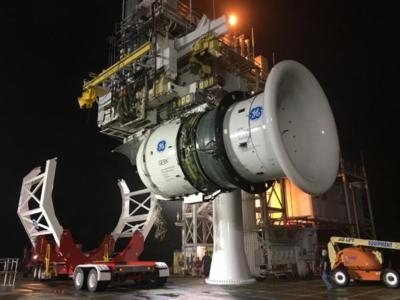Will Power Boeing 777X Aircraft
Earlier this week, GE Aviation began GE9X engine certification tests at its Peebles Test Operation (PTO) in Ohio. The GE9X will power Boeing's new 777X aircraft.

The first round of GE9X certification tests are being conducted on the second GE9X production-configured powerplant built by GE. To prepare for the certification program, trials of the first full engine to test (FETT) GE9X engine commenced in March 2016, generating critical data on the full engine system and aerodynamic performance, mechanical verification, and aero thermal system validation. Testing of the FETT engine concluded earlier this year with a series of preliminary natural-icing tests at PTO, where the GE9X ran more than 50 test points, accumulating 168 hours and 162 cycles.
"Completing a full year's worth of validation efforts on the FETT engine gave us great confidence heading into the certification program with the second GE9X engine," said Ted Ingling, GE9X general manager at GE Aviation. "By incorporating all the learnings from the FETT engine, we start the GE9X certification program with a stable configuration and position ourselves to meet the schedule and performance expectations of our customers from Day 1 of service entry."
As the second GE9X engine begins testing at PTO, assembly of the third and fourth GE9X engines is well underway at GE Aviation's headquarters in Evendale, OH. The fourth GE9X engine is slated for installation and flight tests aboard GE's 747-400 Flying Test Bed flown out of GE's Mojave Desert facility in Victorville, CA, before the end of this year.
Maturation testing of the GE9X engine began about six years ago, progressing from component-level all the way through the completed first full engine to test (FETT) validation efforts. FETT brought all the GE9X technologies together to demonstrate their operability as a complete propulsion system.

In October 2016, GE completed the second phase of GE9X CMC (ceramic matrix composite) component testing in a GEnx demonstrator engine, accumulating 1,800 cycles while exposing the engine to harsh environmental conditions of dust and debris. The level of debris exposure was equivalent to about 3,000 take-off and landing operation cycles. For the second round of tests, the GEnx demonstrator engine utilized the same CMC combustor liners, HPT stage 1 shrouds and HPT stage 2 nozzles from the first round of tests run in September 2015 along with the addition of the HPT stage 1 CMC nozzles.
The use of lightweight, heat-resistant CMCs in the hot section of jet engines is a significant breakthrough in the aviation industry. CMCs consist of silicon carbide ceramic fibers and ceramic matrix and are enhanced with proprietary coatings. With one-third the density of metal alloys, these ultra-lightweight CMCs reduce an engine's weight, which improves fuel efficiency and durability. CMCs are also more heat resistant than metal alloys, allowing the diversion of less cooling air into an engine's hot section. By using this cooling air in the engine flow path, an engine runs more efficiently at higher temperature.
With almost 700 GE9X engines on order, the GE9X engine will be in the 100,000 pound thrust class and will have the largest front fan at 134 inches in diameter with a composite fan case and 16 fourth generation carbon fiber composite fan blades. Other key features include; a next-generation 27:1 pressure-ratio 11-stage high-pressure compressor; a third-generation TAPS III combustor for high efficiency and low emissions; and CMC material in the combustor and turbine.
IHI Corporation, Safran Aircraft Engines, Safran Aero Boosters and MTU Aero Engines AG are participants in the GE9X engine program.
(Image provided with GE Aviation news release)
 ANN's Daily Aero-Term (04.26.24): DETRESFA (Distress Phrase)
ANN's Daily Aero-Term (04.26.24): DETRESFA (Distress Phrase) ANN's Daily Aero-Linx (04.26.24)
ANN's Daily Aero-Linx (04.26.24) Airborne 04.22.24: Rotor X Worsens, Airport Fees 4 FNB?, USMC Drone Pilot
Airborne 04.22.24: Rotor X Worsens, Airport Fees 4 FNB?, USMC Drone Pilot Airborne 04.24.24: INTEGRAL E, Elixir USA, M700 RVSM
Airborne 04.24.24: INTEGRAL E, Elixir USA, M700 RVSM Airborne-NextGen 04.23.24: UAVOS UVH 170, magni650 Engine, World eVTOL Directory
Airborne-NextGen 04.23.24: UAVOS UVH 170, magni650 Engine, World eVTOL Directory




